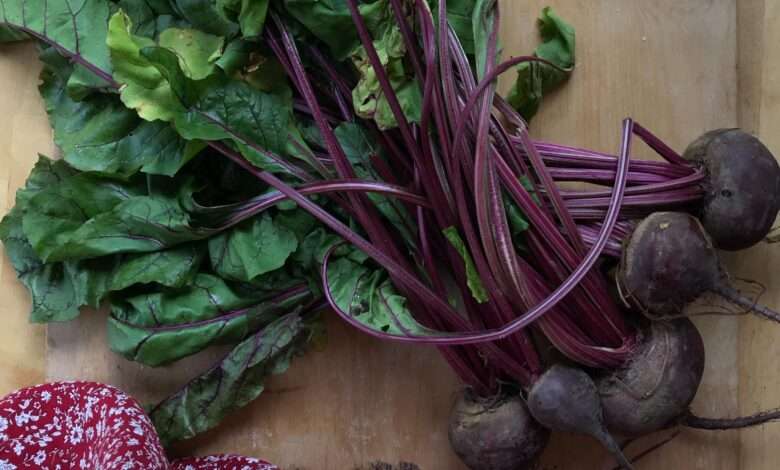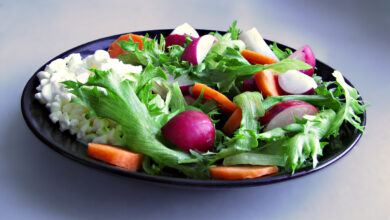
How to choose the right beet?
Beets come in several varieties: red, yellow and white. Red beet, the best known, has such a pronounced color that it is used as dyes in industry. The white beet is used in particular for the manufacture of sugar; it is also called “sugar beet”.
beet id card
- Family: Chenopodiaceae;
- Origin: Mediterranean;
- Season: October to March;
- Red color ;
- Flavor: earthy and sweet.
Properly store beets
- Cellar: 1 to 3 months at temperatures close to freezing point and 95% humidity;
- Refrigerator: 1 to 2 weeks in a perforated plastic bag;
- Freezer: cook them, cut them into slices or cubes and put them in a freezer bag;
- Dehydrator: During the Second World War, it was discovered that beetroot was, of all vegetables, the one that dried best. Cut it into thin slices and put it in the dehydrator or in an oven set to the minimum temperature, leaving the door slightly open.
How to prepare beets
The beet embellishes all the dishes. Its leaves, which can be eaten raw or cooked like spinach, are particularly rich in vitamins and minerals.
Regardless of the cooking method used, it is recommended to cook beets with their skins on to minimize nutrient loss. It also peels much more easily when cooked.
Savor raw beets
Peel the beets and grate them. Add them to a lettuce chiffonade or eat them as is with a homemade dressing. Or, cut them into thin slices and season them in the same way.
Some easy recipe ideas with beets
- Grated and quickly steamed. Coat them with tarragon, mint or dill butter;
- Beet leaves, raw or cooked, are eaten like those of spinach or Swiss chard;
- Cook young beets and their leaves separately and serve them together with an aioli (sauce made from crushed garlic, egg yolk and olive oil);
- In the oven. Place whole beets of similar size in a bowl. Pour a drizzle of olive oil, salt and pepper. Mix well with your hands so that they are well coated in the oil. In an oven set at 250°C (475°F), bake them for 45 to 60 minutes, depending on their size. After letting them cool for a few minutes, peel them by simply sliding the skin off with your hands and serve with the sauce of your choice;
- In potato chips. Peel the beets and cut them into thin slices. Fry them in oil as you would for potatoes. Drain, salt and serve.
Traveling with beets
- In Eastern European countries, people like to start a meal by eating pickled beets;
- In India, beets are simmered with various spices, including turmeric and black mustard seeds;
- The Germans prepare them by cooking them with sauerkraut and diced bacon;
- In Lebanon, they are steamed and coated with a yoghurt, mint and garlic sauce;
- In Russia, they are prepared in a salad with potatoes, carrots, pickled cucumbers and raw onion;
- In France, an excellent salad is prepared with diced cooked beets, lamb’s lettuce and walnut kernels, all drizzled with a walnut oil vinaigrette. If desired, use red, yellow and white roots, making sure to cook the reds separately;
- The Amish add whole, peeled hard-boiled eggs to pickled beets a few hours (even days) before serving them. The eggs then take on a beautiful red color which contrasts pleasantly with their yellow when they are cut on the plate.
Borsch, an Eastern European specialty to discover
- Classic borsch : this traditional soup from Eastern Europe (Russia, Ukraine, Belarus, Poland, etc.) can be prepared in many ways, depending on the country or region. For the basic recipe, cook tomatoes and potatoes in beef broth. In another pan, sauté chopped or grated onions, carrots and green peppers. Add shredded white cabbage and cook for ten minutes. Mix the contents of the 2 saucepans and add cooked and diced beets and lemon juice. Cook for ten minutes. Add parsley, garlic and dill and serve with a little cream and, if desired, the meat used to prepare the broth;
- Cold borsch : Marinate cooked beets overnight in the refrigerator with diced cucumber, minced onion, sour cream and crème fraîche, along with a little sugar and balsamic vinegar. Before serving, put everything in a blender;
- Variations : You can also create a heartier dish by mixing cold borsch with mashed potatoes. Season with ground nutmeg and ginger.
Did you know ? Long before being prepared with beets, borsch was made with a wild herb, hogweed, from which it takes its name. In the past, the beets were first lacto-fermented, which gave the soup its tangy flavor. Today, we no longer go to this trouble. We prefer to add vinegar or lemon juice. But some claim that the final product is of significantly lower quality.
Here are some recipe suggestions:
- Red beetroot and avocado verrine
- beet salad
- beet soup




